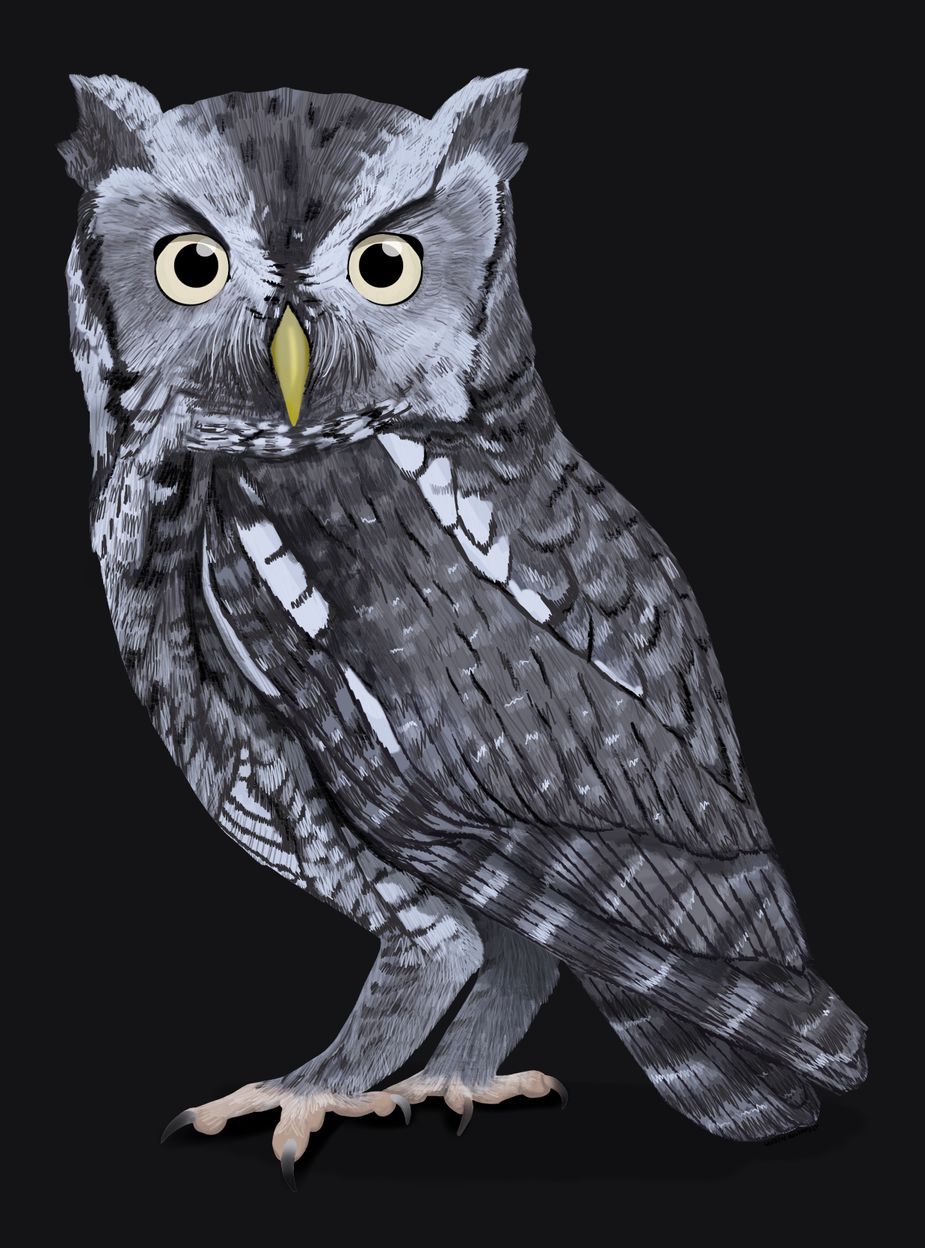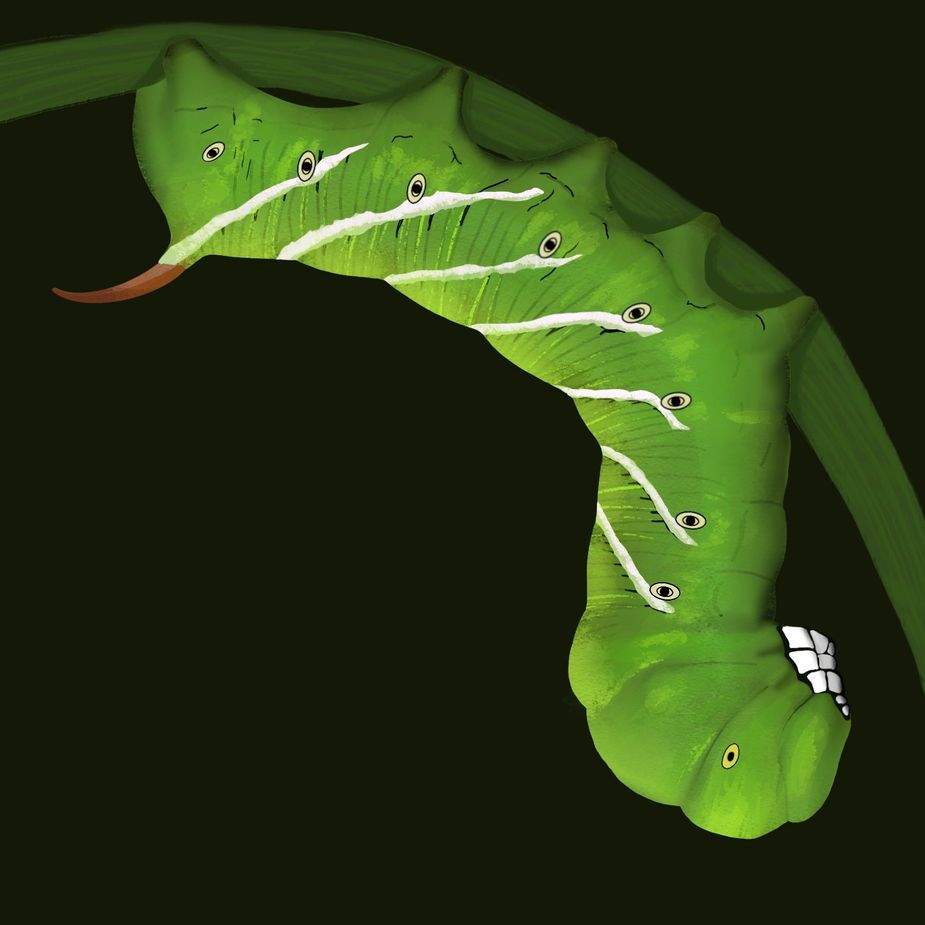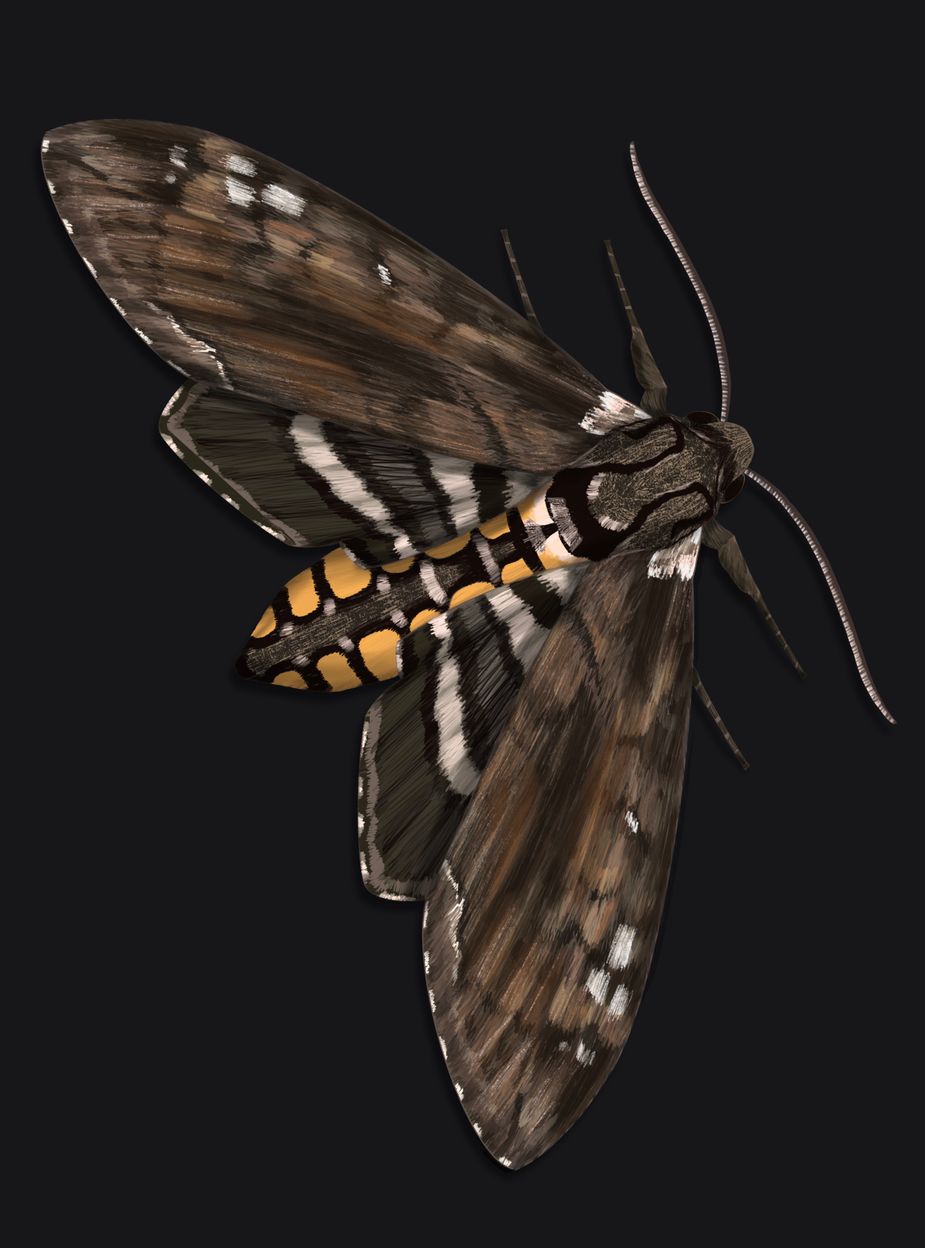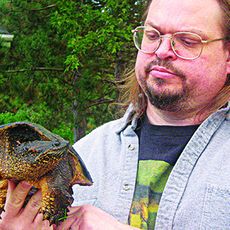Tales from the Dark Side
Published October 2023
By Gordon Grice | 16 min read
When the sun goes down, a whole new world emerges in Oklahoma. Meet a few of the animals who make Sooner State nights come alive.

Eastern Screech-Owl. Illustration by Lauren Rosenfelt
Eastern screech-owl
(Megascops asio)
Sometimes in the woods at night, you hear them talking to each other. From your left comes a stuttering wail like a stuck window finally shuddering open. From your right, the same sound answers. You’re bracketed, but you won’t get hurt. It’s true the owls doing the trilling are on the hunt, but they’re only the size of a robin, and the things they eat are no bigger than a rabbit. Or, say, a squirrel, a mouse, a bat snatched from the air, a tadpole skimmed from the water, an earthworm, a lizard, a blue jay, a dove, or rarely, another screech-owl.
Besides, they aren’t even talking about you. They’re a couple, usually a faithful one, speaking to each other, staying in touch by tremolo. Once you get used to a screech-owl voice, you may like it. The famous naturalist John Burroughs described it as a “soft bur-r-r-r, very pleasing and bell-like.”
When a screech-owl means to make threats, it does so with a different sound. Imagine the ghost of a horse. Imagine the ghost-horse gets hysterical and giggles. Imagine it happens over your head in the dark. Even with better light, you probably wouldn’t see the owl. They come in several colors—a black-banded, streaky, textured-looking gray, the rugged mud-red of pine bark—hues hard to see against trees. Even if something seizes a screech-owl, it may hold perfectly still, playing possum, trusting its camouflage, only at the last minute lashing out with talons. Its most visible part is the lemonade-colored iris of the eye. If it snaps its lids open for a good look at you, the owl looks as if it finds you shocking. This ghost-horse signal warns other owls, marks a territory. But for the little animals they hunt, there is no warning.
Eastern screech owls live in 76 of Oklahoma’s 77 counties—they can be found everywhere except Cimarron County in the Panhandle.

American Badger. Illustration by Lauren Rosenfelt
American badger
(Taxidea taxus)
I had him outweighed by seven thousand pounds. Maybe more, considering the load of broken furniture I was hauling, the teenage son riding shotgun, and the truck itself. Still, the badger wouldn’t back down. He had scampered out to cross the road a few feet in front of the Silverado pickup then halted when he noticed us barreling toward him. His lips rolled back to reveal tiny teeth. He was about as thick as a house cat but built low. His face was a black mask with a milky lightning bolt down the center and milky tear-trails beneath each eye. He growled, lunged.
We felt safe in the truck. He seemed sure he could take us. Miles of spring wheat spread on either side of the road. No traffic; we could sit there for hours if not for our errand.
“The dump closes in ten minutes,” I fretted to my son.
“Maybe you can go around,” he said.
I did. Carefully. My right wheels eased off the pavement and crunched the gravel of the road shoulder. The badger pivoted, teeth bared all the while. In the rearview, he remained standing on the center line, glaring to make sure we didn’t come back.
This was one of the few times I’d seen a live badger on the road, though I’d seen dozens, maybe hundreds, of dead ones. His behavior partly explained why. When they run out in front of a car at highway speed, there’s no stopping in time. They often dart onto roads to eat dead animals only to become roadkill themselves. The main reason I don’t often see live badgers, though, is that they prefer the dark. And what they do in the dark is startling.
It all has to do with digging, which is their great gift. They dig dens that can stretch eight feet deep and thirty feet horizontally. The architecture can get complicated, with, for example, four exits. The badger manages this with claws and a flat body. The powerful front claws work the dirt like pizza dough. The hind legs often kick at the same time, so dirt gets passed back, assembly-line style.
They dig better and faster than other animals—even other burrowers. They’ll eat carrion, insects, lizards, the eggs of ground-nesting birds, and even plants, but they specialize in prey that needs digging out. They dig crawfish out of muddy banks and jackrabbits out of their holes. If a rattlesnake happens to have taken up residence in a prairie dog den, that’s good eatin’. The badger’s own burrow is often the remodeled den of something it ate.
I’ve seen coyotes do some energetic digging, dirt flying out between their hind legs. But even coyotes know badgers are better at it. That’s why the two species have been observed teaming up against prey like ground squirrels. The little rodents live in burrows with two exits. A coyote and badger walk along together—one trotting, the other waddling—and sniffing for just such a burrow. When they find one, the badger goes to work digging, while the coyote locates the other escape hole and stands guard. The panicked homeowner may be dragged to his death through the front door or snapped up as he tries to exit the back. The two predators don’t share the kill. In fact, they growl and nip at each other through the whole hunt. But both parties are willing to put aside differences for a better chance at a meal.
In 2016, scientists discovered yet another way the nocturnal digger gets things done. They wanted to observe the scavenging habits of vultures, so they got hold of seven calves that had died natural deaths and laid them out in the open. They knew, of course, that various other species might take advantage of the buffet, including badgers.
What their cameras caught had never been observed. At two different sites, a badger dug a burrow right beside a carcass. It lived in the burrow, emerging now and then to eat the beef. Over the course of weeks, the badgers excavated tunnels under the carcasses. Finally, the carcasses simply fell through. One of them was only partly concealed, but the other, after a little kicking-in of dirt, vanished entirely from view. Then the badger could eat below ground, with the valuable food hidden from other scavengers.
Scientists already knew badgers would bury small prey, but this was a carcass three or four times the badger’s weight buried through a feat of engineering. If this behavior happens often, it has implications for the ecosystem. For one thing, it might mean the badger is an unexpectedly important player in the recycling of nutrients. For another, it might mean the badger provides a service to ranchers by controlling the spread whenever cattle happen to die of disease.
American badgers are most commonly seen in the western half of the state, particularly in agricultural areas where the soil is easy to burrow into.

Tobacco Hornworm Caterpillar. Illustration by Lauren Rosenfelt
Tobacco hornworm
(Manduca sexta)
You’ve watered the soil they stand in religiously, for Oklahoma skies can’t be counted on. Now, the tomato plants bear a heavy load, not yet red. One morning, on the biggest tomato, you find the glossy green surface gouged and furrowed. The flesh is exposed; even as you watch, gnats gather.
Now that you’re alert for damage, there’s plenty to find. The tomato plant seems to have visited a bad barber; half its leaves are shaved to the middle rib like feathers plucked to the quill. It’s not just this one plant, either—it’s your whole tomato patch. The culprits are not in evidence. Look close, though, and you can find their scat, like pill-sized grenades, sprinkled beneath.
Your county agent will probably tell you there’s no point poisoning the place. Your fingers can solve this. It’s all in the timing. You must rise in the night.
At first, your flashlight finds nothing. Ah, but what’s that moving in the stillness? A tomato stem splits in two. One fork of it, a blunt stub, nods, gropes, takes hold of a tender branch, and sets to work on its leaves. As it devours them, it seems to nod, congratulating itself on the speedy destruction. Now that you recognize it, the caterpillar looms, large as your index finger, striped white. It grasps leaves and draws them to its gobbling mouth with six tiny white limbs. It uses other, stubbier limbs to keep hold of the stem it stands on.
Your county agent has told you it’s fine to pluck the thing off barehanded. Maybe you even try. Ah, but the hideous touch of the thing! It feels as if it may burst into goo. Besides, a formidable-looking red spike juts from its tail. Best to scrape this critter into a tin can. When you do, it lands with a disconcertingly fleshy thump. It wriggles like a sleepy baby to right itself. Only ten or twelve more to gather, and your tomato patch will be safe. This is the tobacco hornworm, devourer of not only tomato and tobacco plants, but also their relatives—jimsonweed, bell pepper, potato, devil’s claw.
Imagine you overlook one of those hornworms. It lives a while longer, eating mostly at night. Soon, it’s time to pupate. The worm goes looking for a place to hide. At this nomadic time of life, the noduled thread that serves as its heart beats visibly through its back. Though it has always preferred the night, now it needs the darkness to survive. Only in total darkness will it begin its transition. Its biochemistry has ordered it so. In a corner of a garden, the hornworm burrows through leaves and soil to rest in darkness.
Though you overlooked it before, you’ll have two more chances to see this creature. But I doubt you will recognize him.
Your next chance comes in spring, when you’re turning over the dirt to prepare your garden for another year. From one shovelful, an odd object tumbles, bigger than a bullet. A delicate handle makes you think of a vase. Up close, you see segments that make it clear this is somehow an insect. But its polished surface doesn’t offend your touch, and it’s unlikely you’ll realize this is one of the squishy intruders you vanquished last summer, now in pupa form. Is it even alive? You toss it aside.
Your final sighting comes one dusk, when you notice a hummingbird at the neighbor’s flowers. Maybe you and the neighbor chat about it, wondering whether it’s really a hummingbird. Because even though it’s hovering like one, it seems too broad-shouldered. It’s too dark for you to notice the tongue-like proboscis that uncoils to probe a blossom. This is part of the gear that, half-formed before, seemed like the handle on a vase. Unwound, it’s twelve inches long. This fuzzy tobacco hawk moth shoulders through the bed of flowers, pollen hitching rides on his feathery gray and brown scales. The pollen gets spread on his nightly round. He can find flowers in the dusk or in the dark. He smells them with his feathered antennae. Also, he sees them. The white ones are easy; even a human can notice them. He can also sense blue and green. He even sees the ultraviolet shades of certain blooms. Though you and I are blind in the dark, beauties remain to be seen.
The tobacco hornworm emerges in late May or early June and feeds for about three weeks before pupating.
Adult hawk moths like the one depicted here begin emerging by mid-July.

Tobacco Hornworm Moth. Illustration by Lauren Rosenfelt
All three of these animals are common throughout Oklahoma. Contact the Oklahoma Department of Wildlife Conservation for more information.
(405) 521-3851
wildlifedepartment.com

.jpeg)

.jpg)



